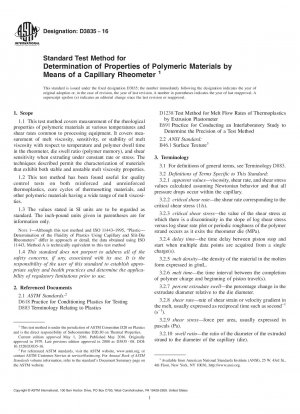ASTM D3835-16
Standard Test Method for Determination of Properties of Polymeric Materials by Means of a Capillary Rheometer
- Standard No.
- ASTM D3835-16
- Release Date
- 2016
- Published By
- American Society for Testing and Materials (ASTM)
- Latest
- ASTM D3835-16
- Scope
4.1 This test method is sensitive to polymer molecular weight and molecular weight distribution, polymer stability—both thermal and rheological, shear instability, and additives such as plasticizers, lubricants, moisture reinforcements, or inert fillers, or combination thereof.
4.2 The sensitivity of this test method makes the data useful for correlating with processing conditions and aids in predicting necessary changes in processing conditions. Unlike Test Method D1238, which makes a one-point measure at a shear rate typically below processing conditions, this test method determines the shear sensitivity and flow characteristics at processing shear rates, and therefore is used to compare materials of different compositions.
1.1 This test method covers measurement of the rheological properties of polymeric materials at various temperatures and shear rates common to processing equipment. It covers measurement of melt viscosity, sensitivity, or stability of melt viscosity with respect to temperature and polymer dwell time in the rheometer, die swell ratio (polymer memory), and shear sensitivity when extruding under constant rate or stress. The techniques described permit the characterization of materials that exhibit both stable and unstable melt viscosity properties.
1.2 This test method has been found useful for quality control tests on both reinforced and unreinforced thermoplastics, cure cycles of thermosetting materials, and other polymeric materials having a wide range of melt viscosities.
1.3 The values stated in SI units are to be regarded as standard. The inch-pound units given in parentheses are for information only.
Note 1: Although this test method and ISO 11443–1995, “Plastic—Determination of the Fluidity of Plastics Using Capillary and Slit-Die Rheometers” differ in approach or detail, the data obtained using ISO 11443, Method A is technically equivalent to this test method
1.4 This standard does not purport to address all of the safety concerns, if any, associated with its use. It is the responsibility of the user of this standard to establish appropriate safety and health practices and determine the applicability of regulatory limitations prior to use.
ASTM D3835-16 Referenced Document
- ASTM D1238 Standard Test Method for Flow Rates of Thermoplastics by Extrusion Plastometer
- ASTM D618 Standard Practice for Conditioning Plastics for Testing
- ASTM D883 Standard Terminology Relating to Plastics
- ASTM E691 Standard Practice for Conducting an Interlaboratory Study to Determine the Precision of a Test Method
ASTM D3835-16 history
- 2016 ASTM D3835-16 Standard Test Method for Determination of Properties of Polymeric Materials by Means of a Capillary Rheometer
- 2008 ASTM D3835-08 Standard Test Method for Determination of Properties of Polymeric Materials by Means of a Capillary Rheometer
- 2002 ASTM D3835-02 Standard Test Method for Determination of Properties of Polymeric Materials by Means of a Capillary Rheometer
- 1996 ASTM D3835-96 Standard Test Method for Determination of Properties of Polymeric Materials by Means of a Capillary Rheometer
- 1979 ASTM D3835-79(1983) Standard Test Method for Rheological Properties of Thermoplastics with a Capillary Rheometer
